Water Management on Turfgrasses
Richard L. Duble, Turfgrass Specialist
Texas Agricultural Extension Service
Text and images copyright © Richard Duble.
Having witnessed the effects of water shortages in many sections
of the country during the past decade, we can appreciate the value
and need for conservation of water. And since scientists forecast
more extensive droughts throughout the next decade, we must become
more conscious of water use. Only through careful management of
our water resources now can we expect to have adequate water supplies
for turfgrass irrigation in the 21st Century. In some sections
of the country, water use for turf irrigation may seem insignificant,
but in other areas it accounts for 50 percent or more of the consumption
of city water supplies during the summer months.
If water conservation does not get your attention, perhaps improved
turf quality will. Both of these effects are products of a properly
designed and managed irrigation system. Simply installing an irrigation
system to provide coverage to a sports field, golf course, or
does not constitute design. Climatic conditions, rootzone properties,
grass species, turf use, and water source must all be considered.
In addition, pipe size, nozzle diameter, operating pressure and
spacings, which together determine the rate and uniformity of
application of water, must also be considered. Efficient use of
water will, in time, become the most important design consideration
for an irrigation system.
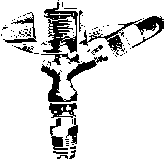
Climatic Considerations
Evaporation Losses. Direct evaporation from sprinklers can
account for a 50 percent or greater loss of water in a desert climate,
or for only a negligible loss of water in humid climates. Evaporation
losses from irrigation increase with solar radiation, temperature,
wind movement, and operating pressures, and decrease with relative
humidity and nozzle diameter. Losses due to evaporation are higher
for single row irrigation systems with little overlap than for multi-row
systems with considerable overlap. Low trajectory nozzles also help
reduce evaporation losses.
Where climatic conditions favor high losses due to evaporation during
summer months, the irrigation system should be designed to operate
at a minimum pressure, to have maximum overlap, to use as large
a nozzle as practical, to use low trajectory nozzles and to operate
during night and early morning hours. Under conditions that favor
evaporation, daytime sprinkler irrigation can require 30 percent
more water than night irrigation.
Transpiration. Transpiration may be defined as the movement
of water vapor through the plant to the atmosphere. Most of the
water transpired through the plant moves through openings in the
leaves called stomates. In actively growing turfgrasses, water continuity
exists from the soil (roots), through the plant, to the leaves where
evaporation occurs through the stomates.
The primary benefit of transpiration is the cooling effect resulting
from the evaporation process. In the absence of transpirational
cooling, leaf temperatures can approach 130°F. In some locations
with grasses such as bentgrass, transpirational cooling must be
supplemented with syringing in midday to increase evaporative cooling
on very hot, summer days.
The amount of water lost through transpiration is a function of
the rate of plant growth (transpiration is very low during the dormant
season) and several environmental factors - soil moisture, solar
radiation, temperature, humidity and wind. Transpiration rates are
highest during summer months when soil moisture, solar radiation,
temperature and wind speeds are high. Transpiration rates are also
higher in arid climates than in humid climates because of the greater
water vapor deficit between the leaf and the atmosphere in dry air.
Thus, transpiration losses may be as high as 0.4 inch of water per
day in desert climates during summer months; whereas, under similar
temperature conditions in humid climates the daily losses may be
only 0.20 inch of water.
In addition to transpirational water losses from turf, evaporative
losses from the soil also occur. With the exception of plant growth
rate, evaporation losses are dependent on the same environmental
variables as transpiration - soil moisture, temperature, solar radiation,
humidity and wind.
The loss of water from the soil by evaporation and through the plant
growing on the soil by transpiration is called evapotranspiration.
During the growing season, transpiration accounts for most of the
evapotranspiration (ET) losses from established turfgrass sites.
Because of the difficulty of measuring ET rates in the field, great
efforts have been made to relate ET to readily available climatic
data. Thornthwaite, Penman and Blaney-Criddle all developed rather
complex equations to relate ET to climatic data. In an effort to
simplify these relationships, turfgrass researchers found that reasonable
estimates of ET can be made from pan evaporation data collected
by most weather stations. For warm season grasses ET can be estimated
by the following relationship:
ET (warm season grasses) = (0.75 x pan evaporation rate)
For cool season grasses the rate is increased to 0.85 times the
pan evaporation rate. These estimates are most accurate during the
growing season for the respective grasses. Estimated monthly ET
rates for Texas locations are shown in Table 1.
In the absence of official pan evaporation data you can collect
your own data using a 4-foot diameter, 10-inch deep pan with vertical
sides. The pan should be placed on blocks so that it is about 6
inches above soil level. You can measure the loss of water, in inches,
by measuring the depth of water in the pan each morning at the same
time. If you are just interested in average ET rates, measure the
depth of water at 3-day intervals and divide the loss by 3. Also,
for warm season grasses multiply the pan evaporation loss by 0.75
to estimate ET rates.

Rootzone Porosity
Porosity. Soils consist of solid particles and pore spaces
which are filled with either air or water. Pore space may account
for 40 to 50 percent of the soil, depending on texture, structure,
degree of compaction, and other variables. Individual pore spaces
are classified as small pores (capillary pores) or large pores (non-capillary
pores). Small pores are generally filled with water and large pores
are filled by air. Total pore space and pore size distribution determine
most of the physical properties of soils that are important to irrigation
practices.
Water moves downward in a soil through the large pore spaces until
the flow is interrupted by a significant change in pore size. A
barrier such as a compacted soil, gravel layer, or clay pan will
impede the downward movement of water. Where these barriers are
near the surface of the soil, irrigation rates and schedules must
be adjusted to prevent excessive surface run-off or leaching, depending
on the nature of the barrier.
Infiltration and Percolation. The rate of movement of water
into a soil is called the infiltration rate. A dry soil may have
a very high initial infiltration rate, but as the soil pores become
filled with water (saturated) the infiltration rate decreases sharply.
In a saturated soil the infiltration rate is equal to the rate at
which water moves through the soil profile-the percolation rate.
The infiltration rate and percolation rate are critical physical
properties of the soil that must be considered when designing and
operating an irrigation system. Both of these properties determine
the rate at which water can be effectively applied to a soil.
Water Retention. The soil serves as a reservoir for water
storage. A clay soil may store 2 to 2° inches of available
water per foot, whereas a sandy loam soil may hold only 1 to 1°
inches per foot. For an irrigation system to be efficient, the water
in the rootzone of the soil should be completely recharged by irrigation
when 50 to 60 percent of the available water has been depleted.
For some turfs this practice may require as little as ° inch
of water or as much as 1° inches per application. Few sprinkler
irrigation systems are designed to apply more than 1 inch of water
per application. Obviously, the more available water the rootzone
will hold, the longer the irrigation interval (days between irrigations)
can be.
Surface Conditions
Turf development and soil surface conditions can restrict water
infiltration rates in the same way that soil profile characteristics
restrict percolation rates. A dense thatch layer, surface crusts,
or a non-wettable sand can severely reduce water infiltration rates.
Unlike soil profile characteristics, these surface conditions can
be readily corrected through cultivation, soil amendments or wetting
agents. Cultivation (aeration, vertical mowing, and topdressing)
provides an effective means of removing and controlling thatch accumulation
in turf.
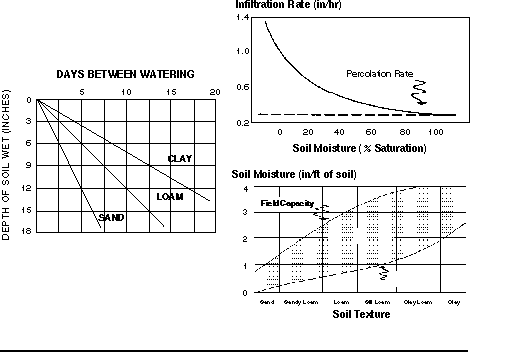
Where thatch accumulation is excessive, significant amounts of irrigation
water may be required just to wet the thatch layer. Evaporation
losses are considerably higher from thatch than from soil. A heavily
thatched turf is usually shallow-rooted which also prevents effective
utilization of irrigation water. Where the root system is restricted
to the thatch layer, light and frequent applications of water are
more efficient than more thorough irrigations.
Soil amendments such as organic matter, calcined clay aggregates
(Greens Choice and Turface), gypsum, or lime may be used to alleviate
surface compaction and increase infiltration rates. When sodium
salts from saline irrigation water disperse the soil particles and
seal the soil surface, gypsum may be used to improve surface conditions.
Under some conditions sandy soils may develop non-wettable properties.
This characteristic has been attributed to an organic substance
produced by soil microorganisms that coats the sand particles and
binds them together. Some wetting agents in combination with aeration
have been effective in alleviating this condition.
Several types of soil profiles are illustrated in Figure 5-1 (A-E).
Figure A represents the ideal situation where soil can be effectively
wetted to a depth of 18 to 24 inches. In figure B, the clay pan
limits the time that the irrigation system can be operated at one
setting, because only the upper 6 inches of soil can be effectively
wetted. If water continues to be applied after the top 6 inches
are wet, the soil will become saturated and run-off will occur.
In Figure C, the rate of application of water is limited by the
percolation rate of the upper 6 inches of soil. Figure D represents
a typical USGA golf green profile. In this case, irrigation should
be stopped after the top 8 to 10 inches of soil are wet. Continued
irrigation after that point would results in excess water losses
due to leaching. Figure E illustrates a situation where surface
compaction restricts the movement of water into the soil profile.
Runoff. Runoff occurs when rootzones are saturated or when
precipitation rate exceeds the infiltration rate of the rootzone.
Runoff is highest in humid climates and is greater during the cool
season than during summer if rainfall is evenly distributed. For
a given annual precipitation, total runoff varies greatly across
the U.S. For example, a mean annual precipitation of 30 inches is
accompanied by runoff in the range of 3 inches in Nebraska, 6 inches
in Tennessee, 12 inches in New York and 22 inches in the Rockies.
These differences are largely due to seasonal distribution of rainfall.
Areas where runoff is greatest receive most of the rainfall in the
winter when only limited radiant energy is available for evaporation.
For the range of precipitation normally found in the U.S., a simple
equation can be used to estimate runoff:
Runoff [as a % of precipitation (P)] = a P2
where a is a variable based on precipitation distribution and radiant
energy. (From Sellers, W.D., Physical Climatology, Univ. of Chicago
Press, 1965.)
For a turfgrass site in Texas a averages 0.005 and runoff ranges
from 15% to 25% of rainfall. For estimating runoff on an annual
basis, I would suggest using 15% on level areas, 20% on areas with
about 1% slope and 30% on a 2% slope. A football field, for example,
with an 18-inch crown down the center line of the field would have
about a 2% slope. Most golf course fairways and lawns have a 1 to
2% slope so that 25% might be a good estimate for runoff on those
sites.
Such information is useful when estimating water needs for irrigation.
For example, a golf course superintendent in Dallas, Texas could
estimate his annual water needs by the following equation:
Water Needs (in/yr) = ET (annual) - [Rainfall - Runoff]
= 60 - [36 - (.25) (36)]
= 60 - [36 - 9]
= 60 - 27
= 33 inches per year
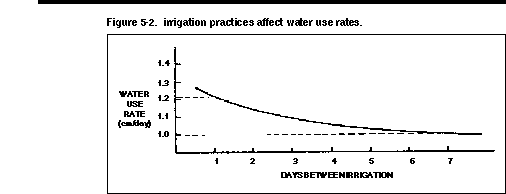
Thus, an average of 33 inches of water would be needed to maintain
growth at a maximum level. On a bermudagrass golf course, good playing
conditions could be maintained with 60 to 70% of the 33 inches or
20 to 23 inches of effective irrigation.
Species and Use
Grasses differ in their water requirements, as some can survive
much greater moisture stress than others. The cool season grasses
are generally more susceptible to moisture stress than warm season
grasses. Buffalograss, for example, can survive long periods of
severe moisture stress, whereas bluegrass would be killed by the
same conditions. Buffalograss may not look any better than the other
grasses during this period, but it would recover when moisture was
restored. However, on sports fields and golf courses, mere survival
is not satisfactory. All turfgrasses require supplemental irrigation
during stress periods to maintain color and growth. During peak
water use periods cool season grasses use from 0.3 to 0.35 inch
per day; whereas warm season grasses use about 0.25 inch per day.
Net evaporation losses
(cm/month) for July.
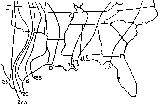
Depth of rooting is the most important factor in the drought
resistance of a turf. A shallow-rooted turf is much more susceptible
to drought injury than a deep-rooted turf. Management practices,
rootzone properties, and turf use have a greater affect on the
depth of rooting than grass species. However, grass species and
varieties differ significantly in depth of rooting. Close mowing,
overwatering, excessive fertilization, soil compaction, and thatch
accumulation all lead to shallow-rooted turf. Golf course putting
greens are excellent examples of turf that are managed to favor
shallow rooting. The roots of most bentgrass putting greens occupy
the surface 2 to 4 inches. Consequently, irrigation schedules
must be adjusted to a light and frequent schedule.
Management practices that promote deep rooting include aeration,
thatch control, proper mowing, proper fertilization and infrequent
irrigation. A deep-rooted turf uses water more efficiently than
a shallow-rooted turf because it can go longer between irrigations
(Figure 5-2).
Irrigation Practices
To maximize efficiency of water use by turfgrasses, irrigation programs
should be based on cumulative evapotranspiration losses, soil moisture
retention, effective depth of rooting, infiltration rate, and type
of turf being irrigated. An irrigation program set up on a calendar
basis is much less efficient than one based on the above criteria.
Water use on a daily basis can be estimated from pan evaporation
measurements, which are available from weather stations throughout
the U.S.
Today, computerized irrigation controllers are available that provide
irrigation programs based on evaporation data inputted several times
an hour and accumulated on a daily basis. Also, automatic adjustments
in the program are made daily based on rainfall, temperature and
other environmental parameters. These controllers take the "art"
out of water management and replace it with "science".
Irrigation systems should be designed to meet the water requirments
of turf during the months of maximum use. For example, locations
that have a net evaporation loss of 15 cm (6 inches) during the
month of July should have the capability of applying about 4 cm
(1-1/2 inches) of water per week. Whether the 1° inches of
water is applied in two or more applications will depend on turf
use, soil moisture retention, infiltration rate and depth of rooting.
If the turf is deep-rooted and in a soil capable of holding 1-1/2
inches of water in the effective rootzone, the entire amount could
be applied in a single irrigation. Or, where the infiltration rate
restricts the rate of water movement into the rootzone, the water
could be applied in a series of intermittent irrigations. If the
turf is shallow-rooted or if the soil will hold only 1 inch of water
in the rootzone, the water should be applied in two or more irrigations.
On an annual basis, warm season grasses will use 40 to 60 inches
of water per year, depending on the availability of water. A well
watered bermudagrass fairway will use about 60 inches of water per
year, or 1.6 million gallons per acre. The same fairway could be
maintained in equally good condition with about 40 inches of water,
a 33 percent savings in water alone. In addition, energy needed
to pump the water, wear on the equipment and fertilizer losses are
also significantly reduced.
Under intensive maintenance such as sports fields and golf course
fairways rainfall meets about half of the water needs in southern
states; irrigation must provide the remainder. Thus, irrigation
must provide 20 to 30 inches of water per year in the South and
40 to 50 inches in the West, for warm season turfgrasses. These
numbers equal 0.5 to 1.5 million gallons of water per acre or 12
to 36 thousand gallons per 1,000 sq. ft. of turf. Obviously, these
quantities of water represent significant dollars.
By promoting deep rooting through thatch control, aeration, moderate
fertilization and infrequent irrigation, significant quantities
of water can be saved. Further savings can be achieved by planting
drought resistant grass varieties.
Practical Water Management
The objective of a turfgrass manager is to provide as fine a lawn
or playing surface as desired with a minimum use of labor and resources
such as water. Although much of the previous discussion concerned
the maximum, or potential, use of water by turfgrass; in practice,
grasses can only use the water that is available to them. Thus,
where precipitation is below the potential water use rate, the actual
water use equals the effective precipitation (Rainfall + Irrigation
- Runoff). In situations where the rootzone is very shallow, leaching
losses must also be considered. Otherwise, for simplicity, we can
disregard leaching.
For example, in a non-irrigated gently sloping site in central Texas
where rainfall for 1992 was 30 inches, the water use rate can be
calculated as follows:
Water Use Rate = Rainfall - Runoff
(inches per year)
= 30 - [.005(30)2]
= 30 - 4.5
= 25.5
Thus, even though the potential water use rate for central Texas
is about 60 inches the actual water use rate for 1992 was only about
25 inches. The question the turf manager must decide is, "was
the quality of turf adequate for that site?" If not, how much
additional water is necessary?
From observations in Texas we know that bermudagrass will survive
with about 20 inches of water per year. From research we know that
bermudagrass can be kept green during the growing season with only
50% of the potential water use rate, or about 30 inches per year,
if the applications of water are timely. For a lawn, 30 inches of
water may be all that is needed. But, for a sports field or golf
course where growth is needed for recovery, more than 30 inches
might be needed.
Therefore, if your objective is water conservation, 20 inches is
needed for survival, 30 inches for acceptable color and about 40
inches for adequate color and growth. Those values are for common
bermudagrass. Hybrid bermudagrass such as Tifway and Tifgreen require
slightly more water for the same level of maintenance.
Buffalograss is similar to common bermudagrass, but buffalograss
will survive with only about 15 inches of effective rainfall. However,
water requirements for maintenance of color and growth are about
the same as for common bermudagrass.
For St. Augustine grass those same parameters might be 30 inches
for survival, 40 inches for color and 45 inches for color and growth.
Zoysiagrasses are similar to St. Augustine grass.
Tall fescue, ryegrass and bluegrass have the highest water requirements
for Texas. Although these grasses can survive with only 30 to 35
inches of water, they require in excess of 50 inches to maintain
acceptable color and growth.
To maintain turfgrasses with the amount of water indicated in the
above discussions, turf managers must apply water effectively. One
method of effective water management is to recharge the rootzone
at intervals that allow the grass to show slight moisture stress-wilting
and discoloration. For example, bermudagrass growing in deep sand
might be irrigated at 5 to 7 day intervals with 1 inch of water.
The same grass in the Texas Hill Country, where rootzones are typically
shallow, may require 0.5 inch of water at 2 to 3 day intervals.
Extending the interval between irrigations to the point of showing
moisture stress promotes deep rooting of turfgrasses. However, the
entire rootzone must be recharged when water is applied.
Sloping sites and sites with very low infiltration rates must be
irrigated intermittently to reduce runoff. For example, the site
may require 0.75 inch of water to recharge the rootzone, but the
infiltration rate may be only 0.25 inch of water per hour. Putting
out all the water needed in one irrigation cycle would result in
significant runoff. However, by applying only 0.25 inch of water
per cycle and repeating the cycle at 1 to 2 hour intervals, runoff
can be significantly reduced.
Through conscientious water management homeowners and professional
turfgrass managers can conserve water resources and still provide
attractive lawns and sports fields.
Watering Golf Greens
A golf green presents special problems in regard to irrigation,
since a dry soil surface is quite hard and will not hold a golf
shot. As a result, a golf green receives between 1/5 and 1/4 inch
of water per application and, during summer months, may be irrigated
daily. Such a practice promotes shallow rooting, weed germination,
disease development and soil compaction. A better solution to the
hard surface problem would be to modify and cultivate the soil so
that it will hold a golf shot even when moderately dry.
Moisture-indicating instruments called tensiometers may be used
to measure the moisture status of the soil and indicate when irrigation
is required. They consist of a porous cup, a vacuum gauge and a
water-filled connecting tube between the cup and the gauge. When
the cup is placed in the rootzone of the soil, water is free to
move through the porous wall and come to equilibrium with the soil
water. As the soil dries, water moves from the cup and causes a
vacuum to be indicated on the gauge; thus, the drier the soil, the
higher the gauge reading. When irrigation water is applied or rainfall
occurs, water returns through the porous cup and releases the vacuum,
which lowers the gauge reading.
By placing the tensiometers at several depths and observing daily
or weekly, it is possible to estimate how often irrigation is needed
and the depth to which water should penetrate to recharge the rootzone.
Moisture readings with these instruments represent only a small
area of soil that surrounds the cup, therefore, sufficient locations
over the area should be established so that a representative measurement
of soil moisture can be obtained.
Irrigation schedules based on tensiometer readings that indicate
moisture stress are much more efficient in terms of water use than
schedules established on a calendar basis.
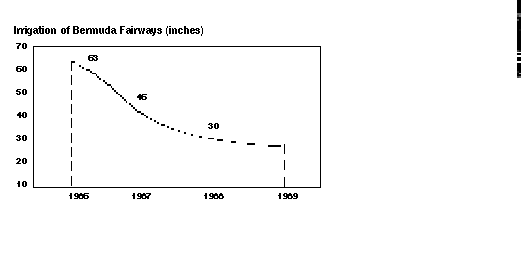
Reductions in water use brought about by monitoring the water needs
of bermudagrass fairways using flow meters and tensiometers. The
quality of turf was improved each year and approximately 25 million
gallons of water was saved on 30 acres of fairways.
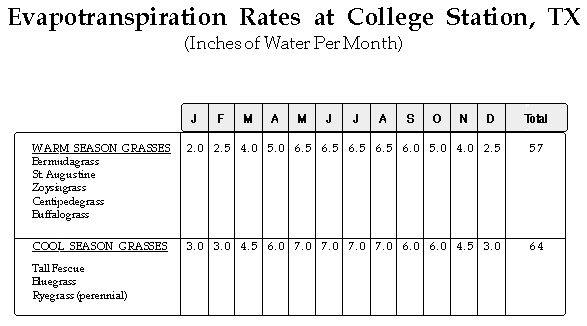
Watering Schedules
Watering schedules depend on grass species, soil type, slope, site
use and other turf management practices.
Grass Species (Drought Resistance)

Grasses with poor drought resistance may need 3 or 4 irrigations
per week during summer months; whereas, those with excellent drought
resistance may need only one irrigation per week.
Between 1/3 and 1 inch of water should be applied per irrigation
depending on turf use, soil type, depth of rootzone and slope. Sports
fields and golf course fairways require 0.5 inch or less per irrigation
when the site is being used on a regular basis. Lawns should receive
0.5 inch or more per irrigation. Sandy soils require lighter, more
frequent irrigations than loam or clay loam soils. And, lawns with
a shallow rootzone (4 inches or less) require lighter, more frequent
irrigations than lawns with deeper rootzones. Likewise, sloping
sites require lighter, more frequent irrigations than level sites.
Water Budgets

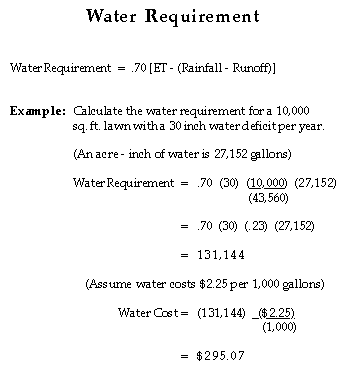
Total Costs for Irrigation
Example:
Total Irrigation Costs = Water + Labor + Equipment + Operating
For a 10,000 sq. ft. residential lawn with a 30 inch water deficit
per year the total irrigation costs might include:
Water Costs
$295 (see above calculation)
Labor Costs
50 hours (to monitor, operate and repair the system) at $8.50 per
hour equals $425
Equipment Costs
$2,500 for system installation depreciated over 20 years or $125
per year
Operating Costs
$35 for repairs plus $75 sewage charge for residential water use
Total Irrigation Costs
$295 + $425 + $125 + $35 + $75 = $955
If the homeowner provided the labor, he could deduct the $425 labor
costs. Nevertheless, the example shows that water costs are only
a portion of the total irrigation costs to a homeowner or client.
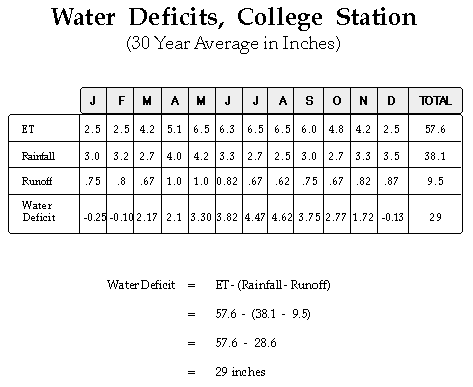

|
















